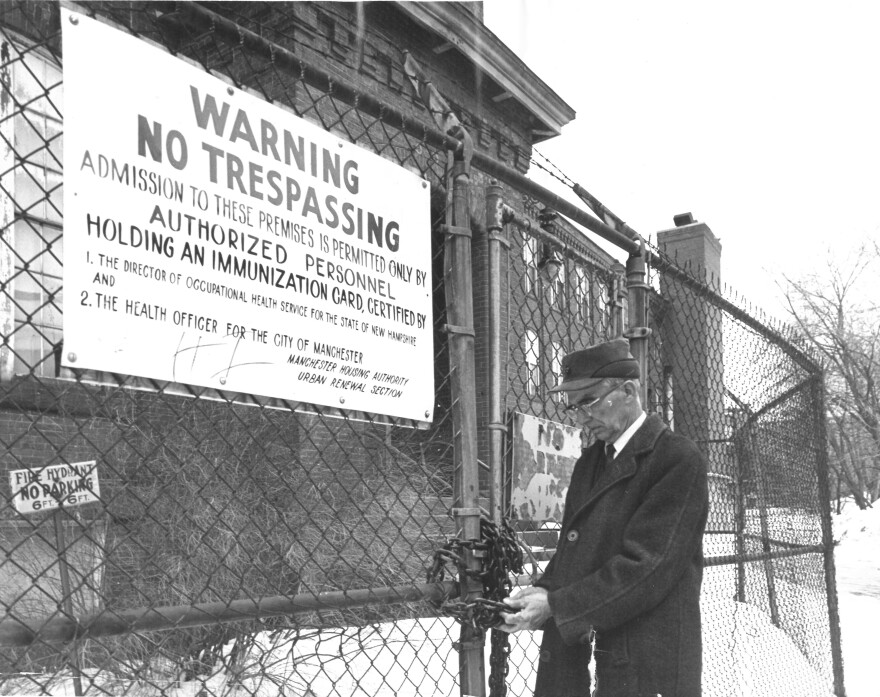It’s been 60 years since workers inside a New Hampshire textile mill began getting sick with a mysterious illness. Over a ten week period, four of these mill workers would die, sparking a massive public health investigation.
The incident was eventually traced to an outbreak of anthrax bacteria hidden inside a shipment of goat hair.
Antonio Jette was a devout Catholic, father of seven, and employee at the Arms Textile Mill in Manchester, New Hampshire. He rarely took vacations, but in September of 1957, he and his wife Anna drove to Rutland, Vermont to the state fair.
“They went to go to the fair cause he always wanted to go see the animals,” explains Anita Simonds, now 90, the oldest of the siblings.
But just as he entered the fairgrounds, Jette turned to his wife and told her he needed to sit down. He was 49 years old and otherwise healthy, but Jette felt overcome by exhaustion. He had a cough, a fever and no appetite.
The Jettes stayed in Vermont for another night, then returned to their home in Nashua. On September 5th, he woke up as he usually did for 7am mass.
“At quarter of seven, he used to go by the convent which is right next to the church, and the sisters used to say they set their clock by him everyday,” says Simonds.
After mass, still not feeling well, Jette decided to return home. He greeted a neighbor along the way.
“He went upstairs, he fell across the bed and when my sister came home at noon, he was unconscious on the bed.”
A doctor came to the house, where Jette was found to have a 103 degree fever. He received penicillin, and was diagnosed with a severe cold, possibly bronchitis.
But by 4 PM, his condition had further deteriorated, and he was unresponsive. At 6 PM, he was admitted to St. Joseph Hospital in Nashua with a temperature of 105 degrees, his breathing rapid and shallow.
Doctors flooded him with more antibiotics, while Anita, her mother and her six siblings held a vigil at his bedside.
“And that’s it. He never woke up.”
Antonio Jette died on the morning of September 6th.
Over a ten week period in the fall of 1957, two other men and one woman, all employees of the Arms Textile Mill, would suffer similar fates. It was the deadliest outbreak of anthrax in the country’s history.

Tracing the Source
To understand how anthrax got inside the Arms Textile Mill, Susan Jones says you have to understand how anthrax, known to scientists as Bacillus anthracis, exists in the natural world.
Jones is a professor at the University of Minnesota, a veterinarian, and the author of Death in a Small Package: A Short History of Anthrax.
“What happens in its natural life cycle is a herbivore will pick it up from the grass in a field,” explains Jones.
The animal - say, a cow, or a goat - then becomes ill, and ultimately dies.
“One of the things that the disease does is to cause a great deal of bleeding from all the bodily orifices after death. And that blood contains a lot of bacilli.”
That blood spills anthrax back onto the grass, where another animal comes along, and eats it, completing the gruesome cycle. In humans, anthrax arrives in three forms.
“The first is, you can eat it in infected meat. That’s very rare in the United States,” says Jones. “Or you can get it into an open wound in the skin, called the cutaneous form of anthrax. And the third way - and the most deadly way - is inhalational anthrax.”
Inhaling anthrax is how most of us know about anthrax, as a biological weapon stuffed inside of an envelop or a package.
Cutaneous anthrax, the second form, is far more common. The bacteria causes a nasty-looking black sore to form on the skin. That’s actually where the term anthrax comes from: it derives from the Greek word for coal.
Cutaneous anthrax was well-known inside textiles mills that processed animal hair in both the U.S and the United Kingdom. It even had a name: Woolsorter’s Disease.
Still, in 1957 at the Arms, Susan Jones says it took investigators a while to figure out the cause. That was, in part, because the men and women getting sick worked in different parts of the building.
“Some of them worked in the beginning of the process, opening the bales. Some of them worked during the weaving process, some of them removed bits of wool and hair from the machines,” she says. “The only thing they had in common was that they had all participated in the processing of a single shipment of Pakistani goat hair.”

A single batch of dark colored Pakistani goat hair, raw material that was used to make the lining of men’s jackets. As that goat hair worked its way through the Arms, the anthrax spores, which had been hidden inside, were sent airborne, floating down like confetti on the workers.
In total, nine people became sick, five with inhalation anthrax and four more with skin lesions. It was the first outbreak of anthrax in this country’s history.
And it could have been worse, except for a remarkable twist.
In 1957, the United States Army, along with the CDC, happened to be testing a potential anthrax vaccine. Those tests were taking place at four textile mills, including three in Pennsylvania, as well as the Arms Textile Mill in Manchester.
“It was pure luck that it happened. Luck is maybe not the right word,” says Suzanne Debella-Olson with the Manchester Historic Association, which has an exhibit on public health in Manchester up until June 24th.
“But it was pure coincidence that they happened to have the outbreak here when they were testing the vaccine.”
When scientists realized what was happening, they halted their trial and gave the vaccine to every worker at Arms Mill.
No one else got sick. In fact, that experimental vaccine became the basis for the one given today to soldiers.
Anthrax Becomes a Weapon
The Arms Textile Mill continued operating until 1968, when the company went out of business. In 1971, after much planning, the brick building was taken down.
“It was one of the largest decontamination projects in the world at the time,” says Olson.
Men in white suits sprayed the inside with potent mixtures of chlorine and formaldehyde, and an incinerator was brought on site to burn wood and other materials. The bricks would be buried off-site. And that was that for the Arms.
But, of course, this wasn’t the end for anthrax, which would reappear four decades letter, not in its natural form, but as a form of bio-terrorism.
The anthrax letters, arriving shortly after 9/11, killed five people. They were eventually traced to a government scientist, but not before ramping up panic in a country already consumed by it.
In 2004, that fear would reemerge, this time back in Manchester.
Construction was underway on a new baseball stadium. It was being built on the site where the bricks from the Arms Textile Mill were buried.
“There were people in the community who felt that if you dug in the ground, we were going to have this huge anthrax explosion in the community and everyone was going to die, and that’s just not the case,” says Tim Soucy, public health director for the City of Manchester.

Utility workers did actually hit those bricks while sinking some electric poles, which prompted more tests and a few scary headlines. But in the end, no one got sick.
“I think it was driven by fear and not by science at the time, to be honest with you,” he says. “Because we knew the history of these bricks and the level of decontamination that they had gone through, there was really, can you ever say zero risk? No. But probably as close to zero as you can get.”
Antonio Jette, in 1957, probably didn’t rate his risk of dying from anthrax as all the likely, either. His daughter, Anita Simonds, says the whole scenario didn’t make any sense.
“We didn’t even know what anthrax was,” she says.
Her family eventually came to understand that the spores had been hiding inside of goat hair where Jette worked. That they were released into the air, and then took away her dad.








